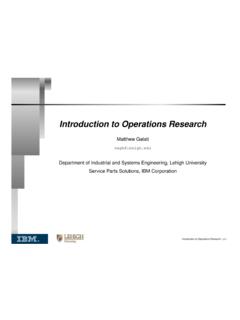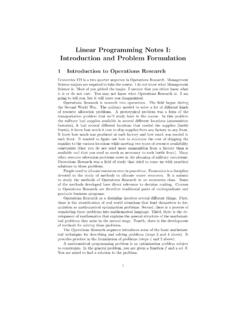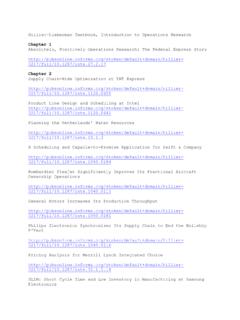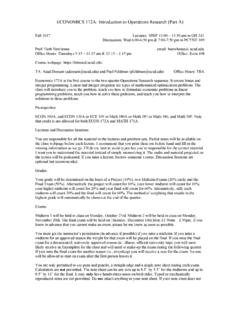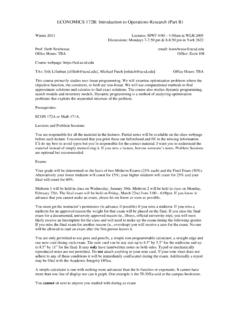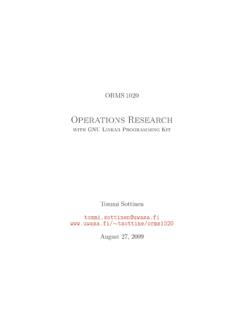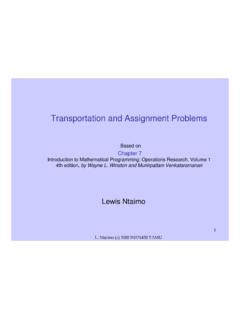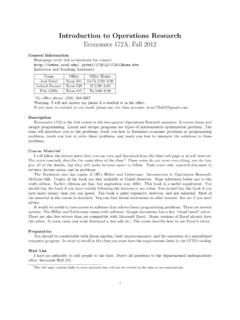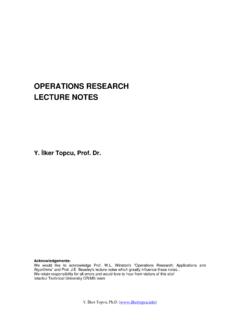Transcription of IE 220: Introduction to Operations Research
1 IE 220: Introduction to Operations ResearchFall 2007 SyllabusInstructor:Prof. Larry SnyderOffice:Mohler 321, phone IDlvs2)Class Hours:T-Th 1:10 2:25 PM, Mohler 451 Office Hours:W 9:00 10:00 AM, Th 2:30 4:00 PM, and by appointment. If my door is open,you re welcome to drop by, but I d appreciate your using scheduled office hours as much Assistant:Tolga office hours M 4:00 5:00 PM, F 11:00AM 12:30 PM, and by appointment. Office and phone number Description:This course will introduce you to deterministic and stochastic models inoperations Research . You will learn to formulate, analyze, and solve mathematical modelsthat represent real-world problems.
2 In the first two-thirds of the course, we will discussdeterministicmodels, in which no uncertainty exists. This section of the course will coverlinear programming and the simplex algorithm, as well as related analytical topics. It willalso introduce other types of mathematical models, including transportation, network, integer,and non-linear models. The remaining third of the course will coverstochasticmodels thathandle the randomness inherent in most real systems. Topics will include Markov chains andqueuing :Hillier, F. S. and Lieberman, G. to Operations Research , 8th ed., NewYork: McGraw-Hill, Scope:We will cover Chapters 1 6, 8 9, 11 12, and 16 17 of the textbook, with additionalchapters added as time :IE 111 or Math 231 (probability and statistics).
3 Corequisites:You must take IE 122, Software Tools, while you are taking IE 220, unless you havetaken it :In this class we will make extensive use of Microsoft Excel and the modeling languageAMPL. You will learn both software packages in IE 122. You should download the studentversion of AMPL :Lecture slides, homework assignments and solutions, and other important materialswill be posted on Blackboard. Please check there :You will have two one-hour in-class exams and a two-hour final exam. The final examwill be cumulative. The exams will be closed-book, make-up exams willbe given,and no credit will be given for any missed :You will have regular homework assignments consisting of problems from the Assignments: Homework assignments must be turned in during class on the day theassignment is credit will be given for any homework assignment turnedin you wish to have a late assignment graded for no credit, we will be happy tooblige.
4 I will drop your lowest homework grade from your average. This means you get onefreebie use it wisely!Legibility: Homework must be typed or writtenneatlyand with problems in the correct we have difficulty reading or following your homework, we will not go to great lengths todecipher it!Plagiarism Policy: I strongly encourage you to consult with your colleagues when you reworking on homework. However, you will not understand the material thoroughly or do wellon the exams unless the work that you turn in is ultimately your own. Therefore, you mustwrite up your answers alone, andwithout looking at anything you wrote down while workingwith your group.
5 This means that if you solved the problem with a friend, you re going tohave to go home and solve it all over again, by yourself. If you wrote AMPL code with afriend, you re going to have to re-write it by work you turn in must beyour your write-up, you must cite everyone with whom you worked or consulted about eachproblem, as well as any books or other references (other than Hillier and Lieberman and thelecture slides) that you used to solve the problem. For example: I worked with FriendlyMcPal on this assignment, or I got help from Smarty McPants about problem #3, or IconsultedLinear Programming for Dummies, Section , by Dopey McBrain when solvingquestion #2.
6 Any breach of this policy will be considered an act of plagiarism, and no credit will be givenfor such offenses will be grounds for failure for the Requests:If you disagree with the grade you received on a homework or exam problem,you may submit a request for that problem to be re-examined. This request must be turnedinin writing no more than 48 hours after you receive the graded contain a clear explanation, in no more than one paragraph, of why you feel the gradeyou received is incorrect. Once we re-examine your work and decide whether to change yourgrade, our decision will be Preparation and Participation:You are expected to come to class regularly and to beprepared for each class by reading the relevant sections of the textbook ahead of time.
7 I willpost slides on Blackboard in advance so that you may bring them to class if you wish. Inaddition, you are expected to participate in class discussions and ask questions when you areconfused. A portion of your grade will be based on class Absences:If you believe you will miss two or more consecutive lectures due to illness,family emergencies, etc., please contact me as early as possible so that we can develop a planfor you to make up the missed material. Under no circumstances will I give credit for missedhomework or exams unless you have discussed your absence with me in :Your grade will be calculated as follows:Homework Assignments: 30%In-Class each (35% total)Final Exam:25%Class Participation:10%Course Objectives:Upon completion of this course, you will be able to:1.
8 Formulate a real-world problem as a mathematical programming model2. Understand the theoretical workings of the simplex method for linear programming andperform iterations of it by hand3. Understand the relationship between a linear program and its dual, including strongduality and complementary slackness4. Perform sensitivity analysis to determine the direction and magnitude of change of amodel s optimal solution as the data change5. Solve specialized linear programming problems like the transportation and assignmentproblems6. Solve network models like the shortest path, minimum spanning tree, and maximumflow problems7.
9 Understand the applications of, basic methods for, and challenges in integer program-ming8. Solve single- and multiple-variable unconstrained non-linear optimization problems9. Formulate a model as a Markov chain and find its steady-state probabilities10. Model a dynamic system as a queuing model and compute important performance mea-suresIf you have a documented learning disability and will be requesting academic accommodation forthis class, please contact Dean Cheryl Ashcroft in the office of the Dean of Students, UC 212, atx84152, or by e-mail at She will establish the appropriate accommodations Course ScheduleWeek ofTopicChapter(s)NotesAug.
10 27 Introduction to Model Building1, 2 Linear Programming3 Sep. 3 Linear Programming3 Sep. 10 The Simplex Method4 Sep. 17 The Simplex Method4 5 Sep. 24 Duality, Sensitivity Analysis6 Oct. 1 Transportation and Assignment Problems8 Exam 1 Oct. 8 Network Models9 Pacing Break(no class T)Oct. 15 Network Models9 Integer Programming11 Oct. 22 Integer Programming11 Non-Linear Programming12 Oct. 29 Non-Linear Programming12 Nov. 5 Markov Chains16 Exam 2 Nov. 12 Markov Chains16 Nov. 19 Queuing Models17 Thanksgiving Break(no class Th)Nov. 26 Queuing Models17 Dec. 3 Additional TopicsReview
